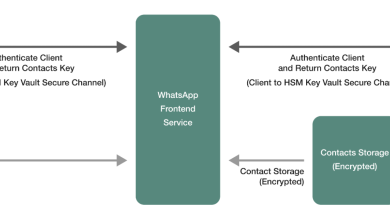How Can Email Marketing Fuel Your Overall Inbound Strategy
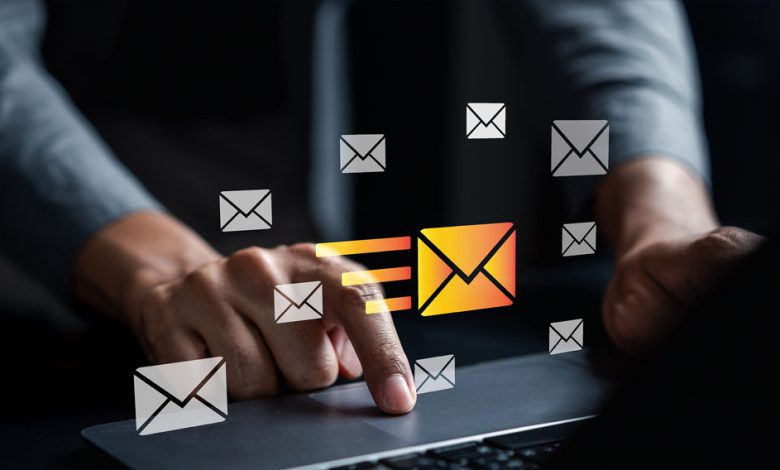
If you’re having trouble attracting and converting clients to your business, now is the time to integrate email marketing into your inbound strategy.
Email marketing is a dynamic tool that can help you reach your audience and earn their confidence because of its affordability, highly-targeted approach, and trackable results. So read on as we discuss email marketing and give you tips on how to incorporate it into your inbound marketing plan to drive growth for your company.
Understanding Inbound Marketing
Inbound marketing is a strategy that attracts customers to your business by creating valuable content and experiences tailored to their needs. It draws potential customers in with useful content and engaging experiences rather than disrupting them with commercials or cold calls.
There are many advantages to inbound marketing. 53% of marketers, according to FinancesOnline, believe inbound marketing produces a higher return on investment.
It not only draws in top-quality leads and boosts ROI, but it also helps you establish credibility and trust with your audience. You’ll increase sales and improve client loyalty by establishing yourself as a thought leader in your field through high-quality content.
How about email marketing, though? You may use email as a powerful tool in your inbound marketing approach to nurture leads and establish connections with your audience.
Your subscribers can stay interested in your brand and be persuaded to take action by receiving personalized and relevant information.
Your Inbound Strategy and How Email Marketing Fits In
The Different Stages of the Inbound Marketing Funnel
Let’s explore the different stages of the funnel before we get into how email marketing fits into your inbound approach. The four steps of the inbound marketing funnel are:
- Attract
- Convert
- Close
- Delight
The attract stage is at the top of the funnel, where you’re attempting to entice potential clients with various marketing initiatives.
You try to convert those potential clients into leads during the conversion step. After acquiring a lead, you proceed to the close stage, when you try to turn them into a paying client.
Finally, in the delight stage, your goal is to keep that consumer and make them an ardent supporter of your business.
The Role of Email Marketing in Each Stage
After reviewing the funnel’s stages, let’s examine how email marketing fits into each one in more detail.
Let’s first concentrate on the attract stage. In order to promote your blog articles and other types of content that drive potential buyers to your website, email marketing can be immensely helpful.
You can boost the likelihood that recipients will click through to your site and engage with your business by creating appealing subject lines and email copy that emphasize the value of your material.
Take this example from Ubersuggest. They discovered SEO problems with the websites of businesses on their email list, so they sent an email outlining the numerous problems they had found and including a link to their app dashboard, which held all the SEO audit information.
They created the ideal subject line for their email and even included an emoji to make it even more attention-grabbing to improve the open rate.

The conversion stage comes next. At this point, prospective clients have shown interest in your brand and are thinking about making a purchase or otherwise interacting with your company.
By providing gated content, like e-books or whitepapers, in exchange for their contact information, email marketing may be a potent tool for turning these leads into consumers.
By offering value upfront, you establish trust with your audience and increase the likelihood that they’ll go to the next stage of the buying process.
As we go on to the closing stage, email marketing can be utilized to target leads who are on the fence about making a purchase. You may entice these leads to act and grow closer to becoming customers by delivering them targeted offers, discounts, and promotions.
The success of your email campaigns in this phase can also be increased by using dynamic content and persuasive text.
Finally, we reach the delight stage. Customers have now engaged with your brand and made a purchase. By offering them unique deals, surveys, and loyalty programs, email marketing can keep them interested.
You can boost the likelihood of recurring business and develop lasting customer connections by offering ongoing value and keeping customers informed about new products, promotions, and other updates.
Examples of How Email Marketing Can Support Each Stage
By understanding how email marketing fits into each stage of the funnel, businesses can tailor their email marketing campaigns to support their overall inbound marketing strategies.
Let’s look more closely at how email marketing can help at each level of the funnel. For instance, a company may send a weekly newsletter to its email list during the attract stage that highlights its most recent blog entries and industry news.
Businesses can increase their credibility and establish trust with their audience by providing valuable content to their email subscribers. Here is an excellent Demand Curve illustration:

In the convert stage, email marketing is an effective way to offer gated content, such as e-books or whitepapers, in exchange for contact information. For example, a business could offer a free e-book on a topic related to their product or service in exchange for a lead’s contact information.
Here is an example from CopyPress, where they want your contact information in exchange for a free e-book.

Businesses can create leads and begin forming relationships with potential clients by exchanging high-quality content for contact information.
In the close stage, a company could send a customized email with a special offer to a lead who has added things to their basket but hasn’t yet made a purchase. Businesses can improve their conversion rates and increase revenue by offering an incentive to make a purchase.
Dealify, a top deals platform for growth marketers, sends this email to nudge you to complete your order.

Finally, in the delight stage, a company could send a consumer a survey asking for feedback on their experience and offer a discount on their next purchase as a thank you. Businesses may boost customer loyalty and encourage repeat business by interacting with clients and providing them with special benefits.
Another good example is Amazon offering a discount on the next purchase, through an email to their existing customers. Here’s one email promoting Amazon Music.
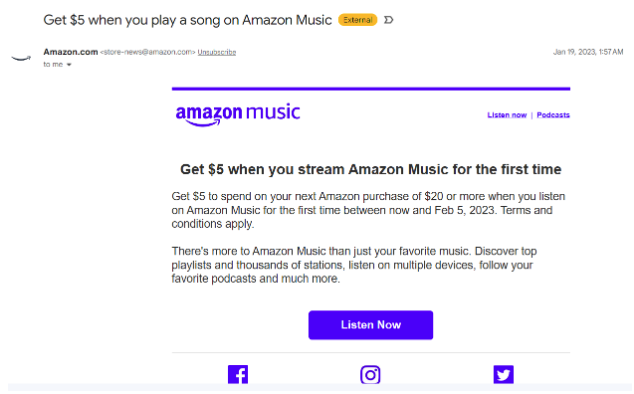
How to integrate Email Marketing with other Inbound Strategies
The Role of Email Marketing in Content Marketing
Together, content marketing and email marketing are effective. While content marketing is great for driving traffic to your website, email marketing is the perfect tool for nurturing those leads and converting them into customers.
Start by producing lead magnets that add value for your audience, such as webinars, whitepapers, and reports, in order to connect email marketing with your content marketing plan. Here’s an example from Hubspot.
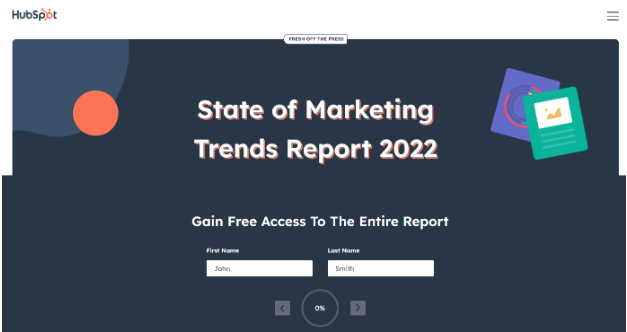
Once you’ve successfully obtained their email addresses through the lead magnets, you should begin nurturing those leads.
Utilize your email marketing software to provide your subscribers with fresh, useful content on a regular basis. This could include blog posts, industry news, tips and tricks, and exclusive offers.
The key is to keep your subscribers engaged and interested in what you have to say. You can also add GIFs to your email to make the conversation interesting.
You may lead your subscribers through the sales funnel as you continue to offer content via email and motivate them to take action. This could entail inviting them to a product demo, advertising a special deal or discount, or simply encouraging them to make a purchase.
This could mean inviting them to a product demonstration, promoting a special offer or discount, or simply encouraging them to make a purchase.
The Role of Email Marketing in Social Media Marketing
Social media marketing is an incredibly powerful tool for connecting with your target demographic and increasing brand recognition. Reaching a broad audience and spreading your message has never been simpler, thanks to the billions of active social media users across numerous platforms.
But while social media is fantastic for short-term gains, it’s email marketing that really shines when it comes to building long-term relationships with your customers. Email allows you to design individualized, focused campaigns that appeal to the wants and interests of your audience.
Over time, this contributes to the development of trust, loyalty, and advocacy—elements that social media just cannot equal.
So how can your social media strategy incorporate email marketing? The first step is to promote your email newsletter on your social media channels. This can be done through posts, ads, and even your social media bio. Here’s an example from Folderly Partners.
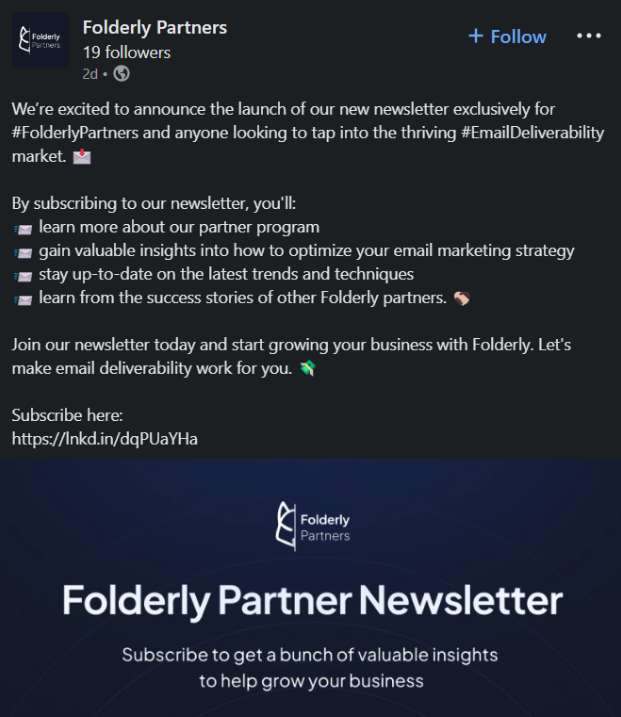
By doing this, you can capture the email addresses of your social media followers and turn them into subscribers. This is a great method to grow your email list and connect with a wider audience.
But it goes further than that. Social media can also be used to advertise your email campaigns and increase website traffic.
You may, for instance, write a post that teases an upcoming email newsletter or gives subscribers access to exclusive content. Your followers may get eager as a result, and they may be persuaded to join your email list.
The goal of incorporating email marketing into your social media strategy is to use the advantages of both platforms to forge more substantial connections with your audience.
You could build a potent marketing machine that generates results for years to come by using social media to grow your email list and to use email to drive conversions.
Combining Email Marketing with Search Engine Optimization

You may get more use out of your content and enhance your digital marketing strategy by repurposing your email newsletter into blog posts. In general, you could reach a larger audience and give your readers useful content in several different formats by repurposing content.
When turning email into blog posts, you could really go into the details as the typical blog length goes beyond a thousand words, unlike email content which is much shorter.
Reviewing previous newsletters and selecting topics that would make fantastic blog posts will help you repurpose your email newsletter into blog posts.
Look for topics that have been successful with your audience. You could also consider combining several newsletters into a single blog post.
After identifying the content you wish to reuse, reword it with your blog readership in mind. Optimize your blog content so it’s easier to read by using headers, subheadings, and bullet points. Include relevant keywords in your title, headings, and main content.
Simply put, make it search-friendly.
Once your blog article has been repurposed and published, you can utilize email marketing and social media to share it with your audience and increase traffic to your website.
Repurposing your email newsletter into blog posts can help you strengthen your connection with your audience while also improving organic visibility and increasing traffic to your website.
Your readers’ relationship with your brand will deepen and trust will gradually develop as you offer them useful information in a variety of formats.
Email Marketing and your Inbound Strategy
Whether you’re just starting out or looking to improve your current marketing efforts, email marketing is an efficient way to reach customers at every level of the inbound marketing funnel.
Email marketing is a vital tool for any organization because of its potential to increase conversions, improve engagement, and develop trust.
For expert help on email marketing and how it can fuel your inbound marketing efforts, work with the top email marketing freelancers here on Toptal.



